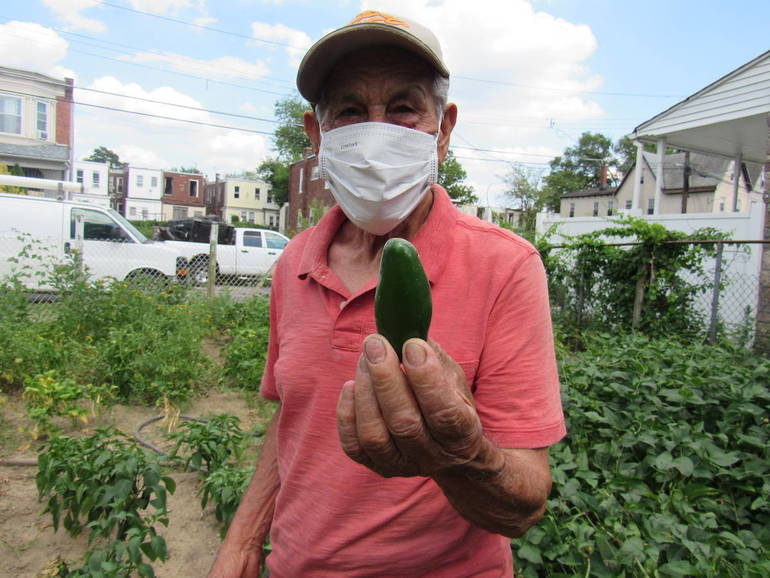
CAMDEN, NJ — A four-day streak of nonstop sun, racking up 100 degrees Monday, led to what Augustine Cordero, 94, was holding in his hand right now.
Half of a green pepper — the appropriate color up top but a moldering brown where he held with his palm. Flakes of dried pepper whisked away by a sudden, and rare, gust of wind.
“Only a couple look like this,” Cordero said, pointing to over a dozen bright green peppers still attached to their stalks. “We’ve been lucky.”
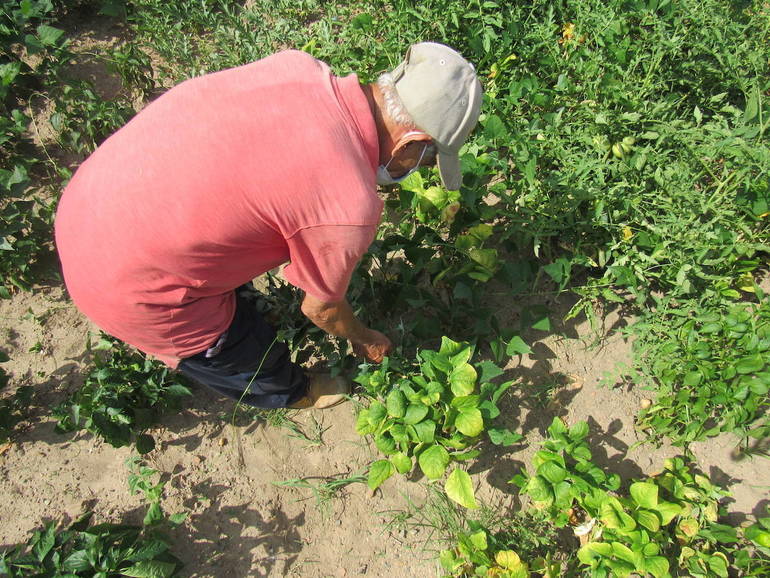
Born in Puerto Rico, Cordero first came to the United States when he was in his 30s. After a brief stint in Florida and then another in New York, he says he settled on South Jersey — and East Camden specifically — more than 50 years ago over job opportunities in construction.
“Esta es la salud mía. This is my health. If I don’t plant and grow I can’t live.”
Augustine Cordero, Urban Gardener
Twenty years later, two houses were demolished down the street from his home. He saw an opportunity to coordinate with the city’s Adopt-A-Lot program to create a garden where he could grow mostly vegetables.
“We eat beans all winter long,” joked Angel Cordero, the 58-year-old son of Augustine Cordero. “But first we get together as a family, get in a circle, and have to work through getting them out.” Angel has six siblings.
The process, Angel explained, is part of the ritual of owning a garden. Maintaining the land, watering the plants and — in the case of the beans — gathering to remove them from their pods.”
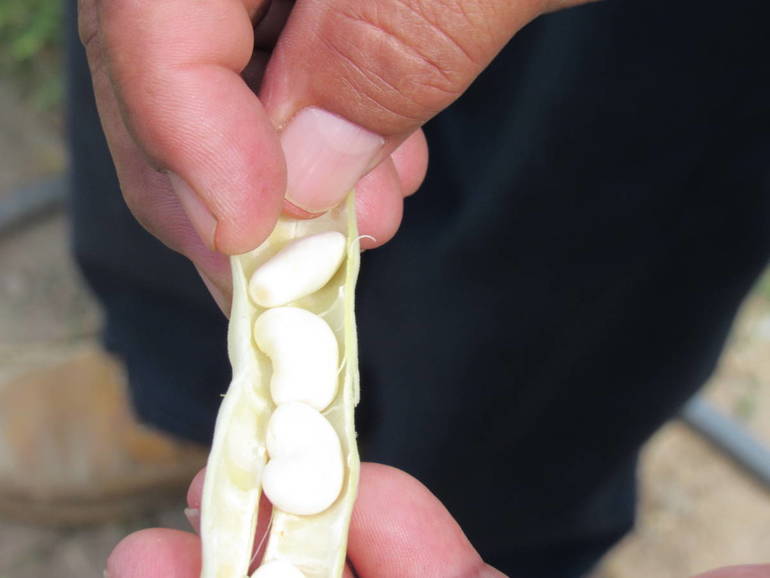
“We also give food to neighbors,” Augustine chimed in. “We don’t sell any of this.”
But there’s no need to make that disclaimer if you’re from the block.
“Como esta papa!” a passerby abruptly shouted as Augustine made his way through the neat green rows. “How are you, friend!”
Seeds shipped from Santo Domingo, Dominican Republic, make it possible for Augustine to also grow “gandules”— pigeon peas that make for the country’s national dish if paired with rice and pork in a pot with sofrito. He’s also made progress with watermelon, corn and other greens – although he says plantains are impossible to grow due to the climate.
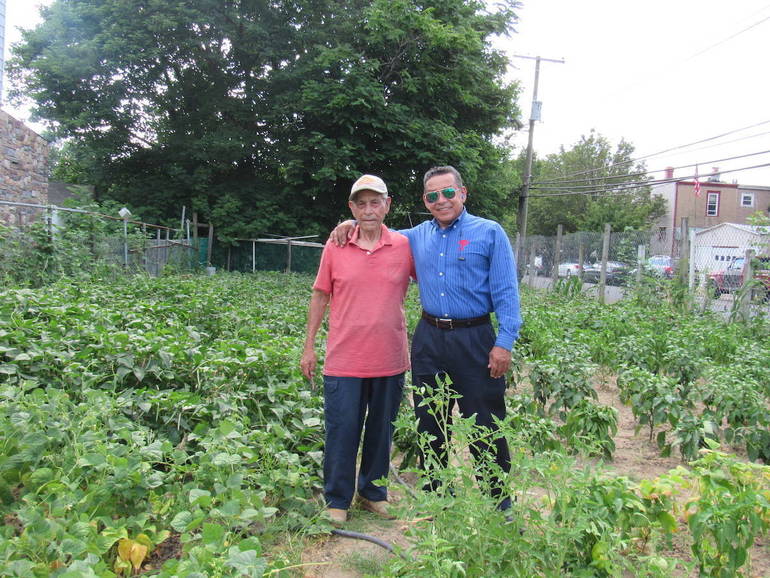
Angel says his father — who turned 94 in April — is as active as ever, despite his age.
“He’s here every morning,” Angel said. “Turning the soil and doing everything else to take care of the garden. It’s a ton of work. But that’s why he’s my role model. This man has worked all his life for his family. Sometimes I wonder where I get it from and where he does, and it’s this…it keeps him going.”
Augustine says he’s been blessed to not have had to face medical hardships as a result of the pandemic.
“Esta es la salud mía,” he said. “This is my health.”
“If I don’t plant and grow I can’t live,” he continued.
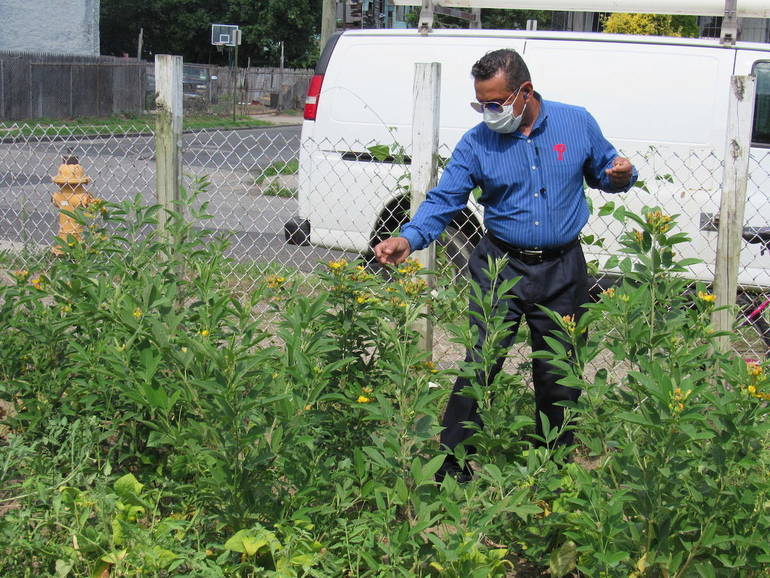
The New Jersey Agricultural Experiment Station (NJAES), an initiative within Rutgers University, is helping to make that brand of tranquility available to anyone across the Garden State who is interested in taking a run at gardening themselves.
The NJAES conducts research on agriculture, horticulture and turfgrass science, as well as provides assistance to farmers, landscapers and residents across 21 New Jersey counties.
In a recently-released fact sheet on “Planning a Vegetable Garden,” the organization harkened back to an old adage: location, location, location.
“Especially for older city and urban areas, we recommend a soil test to check for levels of lead. Right away it’s important to be safe and make sure there are no other potential contaminants that might get into the food,” Peter Nitzsche, Agriculture and Natural Resources Agent with Morris County and co-author of the sheet, said over the phone.
When starting out, a common misstep is size.
“A lot of people bite off more than they can chew,” Nitzsche added. “There’s no minimal size for this sort of thing, even something that’s 5’x5′ is fine for some herbs or lettuce. I’d tend to encourage you to start smaller and then expand after some time. If you start a big garden in the spring, then the heat comes on. It can be overwhelming for some to deal with.”
For those particularly interested in getting in the weeds over what they should and shouldn’t grow, the NJAES provided the following guide:
Vegetable Planting Guide
| Vegetable | Spacing (in.) In Rows |
Spacing (in.) Between Rows |
Transplants or Seeds | Planting Dates* | Avg. Yield per 10 ft. of Row | |
|---|---|---|---|---|---|---|
| Asparagus | 18 | 60 | crowns | Perennial | 5 lb. | |
| Beans, Lima, bush | 4 | 24 | seeds | May, June, July | 6 lb. | |
| Beans, Lima, pole | 36 | 36 | seeds | May, June, July | 7 lb. | |
| Beans, Snap, bush | 4 | 24 | seeds | May, June, July | 7 lb. | |
| Beans, Snap, pole | 36 | 24 | seeds | May, June, July | 7 lb. | |
| Beets | 3 | 15 | seeds | April, May, June, July | 14 lb. | |
| Broccoli | 15 | 30 | transplants | April, May, July, August | 8 heads | |
| Brussels Sprouts | 18 | 30 | transplants | July | 5 lb. | |
| Cabbage | 18 | 24 | transplant | April, July | 7 heads | |
| Cabbage, Chinese | 12 | 18 | seeds or transplants | April, July | 10 heads | |
| Carrots | 3 | 15 | seeds | April, May, June, July | 10 lb. | |
| Cauliflower | 24 | 30 | transplants | July | 5 heads | |
| Celery | 6 | 18 | transplants | May, June | 20 stalks | |
| Chard, Swiss | 6 | 24 | seeds | April, May, July, August | 20 plants | |
| Collards | 18 | 24 | seeds | April, May, July | 10 lb. | |
| Corn, Sweet | 12 | 24 | seeds | May, June | 10 ears | |
| Cucumbers | 36 | 30 | seeds or transplants | June, July | 8 lb. | |
| Eggplant | 30 | 30 | transplants | May, June | 20 fruit | |
| Endive | 12 | 18 | seeds or transplants | April, May, July, August | 10 plants | |
| Kale | 15 | 18 | seeds | July, August | 24 lb. | |
| Kohlrabi | 4 | 15 | seeds or transplants | April, May, July, August | 20 bulb. | |
| Leeks | 3 | 15 | transplants | April, May, August | 40 plants | |
| Lettuce,Leaf,Romaine | 8 | 15 | seeds or transplants | April, May, August, September | 15 heads | |
| Lettuce, Bibb | 6 | 15 | seeds or transplants | April, May, August, September | 20 heads | |
| Muskmelons | 36 | 72 | seeds or transplants | June | 8 melons | |
| Mustard Greens | 12 | 15 | seeds | August | 10 lb. | |
| Okra | 24 | 36 | seeds | May, June | 100 pods | |
| Onions, Dry | 4 | 15 | seeds, transplant sets | April | 10 lb. | |
| Parsley | 6 | 15 | seeds | April, May, June | 20 bunches | |
| Parsnips | 3 | 18 | seeds | April | 10 lb. | |
| Peas | 2 | 18 | seeds | March, April | 3 lb. | |
| Peppers | 15 | 15 | transplants | June | 12 lb. | |
| Pumpkins | 48 | 96 | seeds | June | 4 fruit | |
| Radishes | 1 | 12 | seeds | April, May, June, July, August, September | 60 roots | |
| Rhubarb | 36 | 48 | crowns | Perennial | 20 stalks | |
| Rutabagas | 4 | 18 | seeds | April, July | 15 lb. | |
| Spinach | 4 | 18 | seeds | April, September | 7 lb. | |
| Squash, bush | 24 | 48 | seeds or transplants | July, July | 25 fruit | |
| Squash, vine | 36 | 72 | seeds or transplants | June | 20 fruits | |
| Sweet Potatoes | 12 | 36 | transplants | June | 12 lb. | |
| Tomatoes | 24 | 36 | transplants | May, June | 50 lb. | |
| Turnips | 3 | 18 | seeds | April, July | 7 lb. | |
| Watermelons | 36 | 96 | seeds | June | 3 melons | |
| White Potatoes | 12 | 24 | tubers | April | 18 lb. |
This story was produced in collaboration with CivicStory and the New Jersey Sustainability Reporting project. It was originally reported by Steven Rodas for TAPinto Camden, and may be re-distributed through the Creative Commons License, with attribution.
